new posts in all blogs
Viewing: Blog Posts Tagged with: iphone, Most Recent at Top [Help]
Results 1 - 25 of 142
How to use this Page
You are viewing the most recent posts tagged with the words: iphone in the JacketFlap blog reader. What is a tag? Think of a tag as a keyword or category label. Tags can both help you find posts on JacketFlap.com as well as provide an easy way for you to "remember" and classify posts for later recall. Try adding a tag yourself by clicking "Add a tag" below a post's header. Scroll down through the list of Recent Posts in the left column and click on a post title that sounds interesting. You can view all posts from a specific blog by clicking the Blog name in the right column, or you can click a 'More Posts from this Blog' link in any individual post.

By:
Monica Gupta,
on 7/20/2016
Blog:
Monica Gupta
(
Login to Add to MyJacketFlap)
JacketFlap tags:
health,
Articles,
iPhone,
game,
trade,
catch,
Pokemon Go,
and battle,
Android device,
Real World with Pokémon GO!,
universe of Pokémon to find,
कैंडी पाइंट,
गार्ड,
टीम मिस्टिक,
पोकीमॉन गो खेल,
लैंडमार्क,
Add a tag
पोकीमॉन गो, पोकेमॉन गो या Pokemon Go प्लीज गो …. पहले कान में ईयरफोन लगा कर संंगीत लगा कर, सडक पर चलने पर तीव्र आलोचना हुआ करती थी कि ये सडक दुर्धटना का निमंंत्रण देता है तो अब पोकीमॉन गो को क्या कहेंगें समझ से बाहर है… मुम्बई में मैनें अपनी सहेली को फोन किया […]
The post पोकीमॉन गो, पोकेमॉन गो या Pokemon Go appeared first on Monica Gupta.

By: Jerry Beck,
on 2/4/2016
Blog:
Cartoon Brew
(
Login to Add to MyJacketFlap)
JacketFlap tags:
Ian Jones-Quartey,
Rob Sorcher,
Toby Jones,
Double Stallion,
Lakewood Plaza Turbo,
OK K.O.!,
Games,
Iphone,
Cartoon Network,
Add a tag
The game is based on an original idea by "Steven Universe" supervising producer Ian Jones-Quartey.
The post Cartoon Network Launches First Game ‘OK K.O.!’ Lakewood Plaza Turbo’ appeared first on Cartoon Brew.

By:
Heidi MacDonald,
on 11/3/2015
Blog:
PW -The Beat
(
Login to Add to MyJacketFlap)
JacketFlap tags:
Apple,
note,
samsung,
Digital Comics,
bruce,
Bruce Lidl,
lidl,
iphone,
Digital,
ipad,
comixology,
ipad pro,
Add a tag
By Bruce Lidl The digital comics landscape has settled down significantly in recent months. Since Amazon’s acquisition of ComiXology in April 2014, it has become essentially the de facto standard for digital comics and now distributes just about every publisher around. Unless a real industry-wide Netflix-type subscription model ever takes off, it is hard to see […]

By:
nicole,
on 10/17/2014
Blog:
the enchanted easel
(
Login to Add to MyJacketFlap)
JacketFlap tags:
halloween,
art,
iPhone,
children's art,
kawaii,
whimsical,
tim burton,
original painting,
the nightmare before christmas,
the enchanted easel,
sally,
nuvango,
phone cases,
Add a tag
 |
iPhone 5s case with my painting, "moonstruck".
©the enchanted easel 2014 |
and i couldn't be happier with this company,
nuvango.
when first uploading my work i and some issues with the SRGB profiles, apparently the pics i uploaded were not in the correct format. well, they were unbelievably helpful and just wonderful to work with....helping me through everything step by step. and the payoff? gorgeous. the phone cover fits like a glove and the color payoff is like looking at the original canvas, sitting in my studio.
so....i highly recommend
nuvango for phone cases, laptop skins and lots of other cool treats.
{i know this is seasonal, but i love it so much i may have to keep it on year 'round! :)}
AniRef is an app created especially for animators who need to record, analyze, and track arcs in reference footage. It was created by recent Ringling grad Paolo Cogliati who currently works at The Mill in New York. “Ive been taking it around with me outside of the studio and recording spontaneous things I find and see while roaming the city,” he says of the demo below. “This child walked into frame without me knowing while I was recording people’s feet to scrub through, and made my day! I don’t think I’ve ever seen something so close to a Pinocchio walk in real life!” The app includes the following features: Record actions and add to your library for future reference Analyze footage frame by frame, at multiple frame rates Track arcs, spacing and timing by positioning trackers View your tracking in 4 different display modes Export and Email your tracked footage as .mov and import into your 2D/3D software for ease of workflow Playback in slow motion or at 24 FPS> Bookmark your key poses with the StarPose tool and toggle from key to key Know exactly what frame you are on with the embedded frame count Save your reference to the AniRef library, separate from your regular videos for easy finding and privacy AniRef on the iOS is available for $4.99 on the App Store. For more info, visit AniRef.com. Don’t miss any updates from Cartoon Brew. Join Cartoon Brew on Facebook!

By:
Heidi MacDonald,
on 9/4/2014
Blog:
PW -The Beat
(
Login to Add to MyJacketFlap)
JacketFlap tags:
Apple,
iphone,
Digital,
android,
tablet,
note,
samsung,
ipad,
comixology,
Digital Comics,
Top News,
phablet,
Add a tag
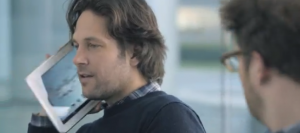
Mobile Device Sizes Changing Rapidly
by Bruce Lidl
While the landscape for digital comics continues to develop in the post-Amazon takeover of comiXology era, the devices upon which those comics will be consumed are evolving as well. New announcements and new devices appear almost daily, with a number of eagerly-awaited devices rumored to hit in the next few weeks, most notably new, larger iPhones. Trends seem to be shifting towards ever bigger mobile phone devices, while tablets begin to cool. Taken together both indications may actually point to a brighter future for digital comics.
The iPad, of course, popularized the tablet category and has remained the segment leader since its launch in April 2010, with almost unheard of sales figures, even while maintaining relatively high price points. Competing devices have flooded the market in the iPad’s wake, but the generally cheaper Android powered devices have mostly filled market niches, while providing a large diversity in size, performance, appearance and media tie-in. Newer models with improved screens continue to appear from Amazon (Fire HDX), Samsung, Sony, Lenovo, Asus, Toshiba and many more in the $175-299 price range, while sales and refurbished older models can bring the prices of modest but name-brand Android tablets down under $100. This wave of tablets, especially those from Amazon and Barnes & Noble, have also had the effect of weakening interest in traditional black and white eReaders, a category that limps along at this point.
In a surprise to many, however, the tablet boom is beginning to slow down considerably in recent months. In Apple’s last financial releases, iPad sales numbers have declined both quarterly and in year-to-year figures. Tablet sales from other manufacturers also seem to be declining, raising the question of where tablets fit into the mobile device ecosystem and why tablet owners are not replacing them as fast as smartphones. Is it a lack of innovation in new tablets? A lack of new use-cases or new applications, that might spur sales? Are older models still capable of doing everything that users want from their tablets (primarily media consumption, web browsing and light email)?

On the other end of the mobile device spectrum, sales continue to climb for smart phones, and will likely only jump further with the release of new iPhones, possibly as early as next week. Tellingly, the major innovation that is expected from the iPhone 6 is screen size: according to the most reliable of Apple watchers, the new phones will continue to increase screen real estate. The original iPhone had a 3.5 inch screen with a 480×320 resolution, while the latest 5S has a 4 inch 1136×640 pixel resolution. The expectations for the iPhone 6 is 4.7 inches with a 1334 × 750 resolution, and an even larger iPhone 6L at 5.5 inches and 2208 × 1242, pushing the latter device firmly into the hybrid category sometimes called “phablet.” Samsung has been the leader in the bigger is better smartphone segment with it’s Android Galaxy Note devices, which have had screens as big as 5.3 inches since 2011, and the latest model, the Note 4 just announced yesterday, is 5.7 inches at 2560 x 1440 resolution. Other highly anticipated upcoming devices include rumored Motorola Nexus devices (“Shamu”) at 5.2 and possibly 5.9 inches. And just to show how expectations of smartphone size has changed, a recently announced device from Chinese manufacturer ZTE, the Nubia 5S, with a screen of 4.7 inches, 1280×720 pixels, is called the “Mini.”
Is there a link between the slowing in tablet sales and the ever increasing phone screen size phenomenon? Does owning a device like the Samsung Galaxy Note make also carrying a tablet superfluous? Could larger iPhones cannibalize iPad sales, at least of the iPad Mini (7.9 inches, 1024×768 or 2048×1536)? Evidence at this point is very sketchy, and it’s also quite possible that larger phones will just drive tablet manufacturers to increase screen size as well, and in fact there are rumors of a new, larger iPad in the works with a 12.9 inch screen. The next few months, leading into the holiday buying season will clearly indicate the direction the mobile device trends are going in, and whether or not we will have to start looking for pants with larger pockets to hold our monster sized phones.
From a digital comics perspective, the evolution of mobile screens could have a very large impact, particularly as they remain the primary consumption device for such comics. The rise of comiXology matches in many ways the growth of the iPad, and it’s not a coincidence that Amazon wanted to purchase a key digital content distributor to integrate with its hardware offerings. While a weakening tablet market may be somewhat worrisome to digital comics sellers, the explosion of interest in larger sized phones may be a far more beneficial development. Reading comics on smaller phones, even with Guided View type applications, can be very frustrating, but as those screens get bigger and better, smart phones may indeed become more suitable for comics consumption. Reading comics on a 5.7 inch Samsung Note 4 phablet is actually a pretty decent experience and not that far off of 7 inch Kindle Fire in any case. And even more so, if Apple does, indeed, embrace this size trend wholeheartedly with a 5.5 inch iPhone, a device with the prospect of true mass acceptance, the landscape of digital comics friendly devices could grow explosively in the near future.
Animator Lucas Zanotto has released a follow-up to his Drawnimal appcalled Miximal. It's a mix-and-match style children's game in which different combinations of animals can be created. Little bits of animation accompany each section of the animal, and when all three pieces align into a complete animal, the creature peforms a short act.

By: Alice,
on 3/30/2014
Blog:
OUPblog
(
Login to Add to MyJacketFlap)
JacketFlap tags:
bilingual,
twitter,
addiction,
Internet addiction,
hernandez,
*Featured,
cocaine,
Science & Medicine,
Dopamine,
Psychology & Neuroscience,
Arturo Hernandez,
bilingual brain,
cognitive control,
inhibition,
bilinguals,
arturo,
Books,
Technology,
iphone,
Add a tag
By Arturo Hernandez
Before I wrote my last blog entry, I got a Twitter account to start tracking reactions to that entry. I was surprised to see that people that I had never met favorited my post. Some even retweeted it. Within a day, I started to check my email to see if someone else had picked up on it. It felt so good to know that people that I had never met from all over the world were paying attention to me.
The addictiveness of Twitter is not specific to me. There have been articles about getting Justin Bieber to follow you as a form of addiction. But the problem is much more pervasive than that.
Many of the symptoms associated with cocaine addiction are popping up in people who are simply on the Internet. The toxic effects of cocaine addiction have been known for years. Studies find that rats will self-administer cocaine to the point of death over a period of time. The pharmacological effects are also well known; cocaine magnifies the effects of dopamine chemically. The interesting part is that Twitter, Facebook, and video games seem to have a similar effect as well. Thus, dopamine is part of a reward system.
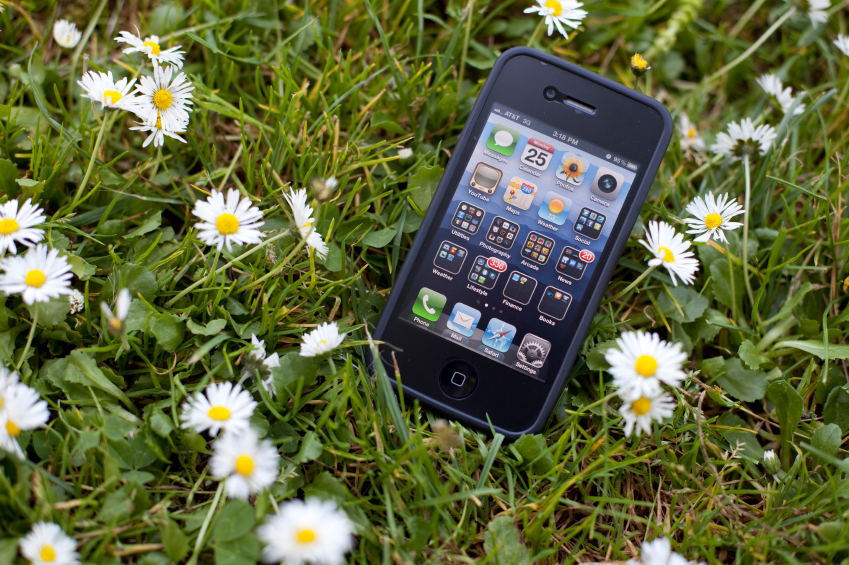
Interestingly, dopamine is also known to play a role in the brain systems that are used to control our mental focus. Recent work has found that dopamine plays a role in the connection between the frontal areas that are involved in cognitive control and the posterior areas of the brain involved in processing incoming information from the senses.
And here, work in bilingual literature might have found an antidote to the plague of Internet addiction. Ellen Bialystok and her colleagues have found that bilinguals tend to be better at switching between tasks and at using inhibition — what researchers call cognitive control. Theoretical work by Stocco, Pratt and colleagues proposes that the use of two languages on a regular basis helps to strengthen the use of brain areas that are highly linked to dopamine. Many of the same frontal areas have been shown to be involved in control in bilinguals. Thus, it is logical to conclude that dopamine which leads to increased addiction may also be involved in giving bilinguals an edge in focusing. It is a classic U-shaped function where too little and too much are bad but somewhere in the middle is just right.
So what happens when a bilingual faces the onslaught of Internet addiction. Is s/he more resistant? I don’t know the ultimate answer to that question. But I was struck by how quickly the Twitter craze that had me checking my page every minute faded. Perhaps it is the four languages that I have learned that serve to protect me more and allow me to stop the urge to check my page again. Today, I am happy to report that I have written this blog entry with the understanding that any benefit will come long term. And I have my language learning history to thank for that.
But, please, favorite this; please, retweet it. Please, please, please!
Arturo Hernandez is currently Professor of Psychology and Director of the Developmental Cognitive Neuroscience graduate program at the University of Houston. He is the author of The Bilingual Brain. His major research interest is in the neural underpinnings of bilingual language processing and second language acquisition in children and adults. He has used a variety of neuroimaging methods as well as behavioral techniques to investigate these phenomena which have been published in a number of peer reviewed journal articles. His research is currently funded by a grant from the National Institutes of Child Health and Human Development. Read his previous blog posts and follow him on Twitter @DrAEHernandez.
Subscribe to the OUPblog via email or RSS.
Subscribe to only psychology articles on the OUPblog via email or RSS.
Image credit: Apple’s iPhone 4 with a busy home screen on the grass with chamomile flowers. © ZekaG via iStockphoto.
The post Dopamine, Twitter, and the bilingual brain appeared first on OUPblog.

It's been a busy stretch for the Thirties Fleischer cartoon star Betty Boop. First, she got her own paper towel in Turkey, and now, Winnipeg, Canada-based Fowl Moon Studios has licensed the character for a new iOS game called Betty Boop Dance Card.

In case anyone was wondering, I *have* decided to upgrade my iPhone to the iPhone 5s. I read ebooks on my iPhone as well as taking a ton of photos, so the improved graphics capability (and especially the new camera features) make it well worth it for me.
More info about Apple's new iPhones in the NYTimes today as well as (of course) on Apple's site.
Get Will Write For Chocolate updates on Facebook.
Filmmaker and animator Arthur Metcalf (Fantaisie in Bubblewrap, It Took A While To Figure Shit Out) has taken a moment between short films to create Stress Baal, a new game app that is now available for iPhone and Android phones. The game, which features a high-strung imp ready to be tortured for the amusement of the player, is like an interactive Duck Amuck, in which the user chooses how often to inflict agony on their character. “You beat him up with your fingertip,” Metcalf told Cartoon Brew. “There’s no score, no goals. It’s meant to just be entertaining rather than addictive.”
His approach to creating the game is not unlike that of one of his films, and the small moments of personality are just as important as the big action scenes. “As a kid, I spent a lot of time just playing with Sonic on my Genesis,” said Metcalf. “Not playing the game, just playing with Sonic’s animation. If you left him alone for a few seconds, he’d cross his arms, kick the ground and so forth. It was this one simple animation, but it added a lot to the game – it made it feel like Sonic was more than just a sprite box sliding around.”
Rather than moving towards digital puppetry with simulated physics, Metcalf challenged himself by sticking to his traditional animation background while simultaneously pushing the number of reactions he could get out of the character. “Part of my decision to make Stress Baal was to try to figure out if this kind of animation would work at all in a game. I was told by a lot of tech guys that it would probably be impossible due to technical limitations, that there was a reason characters had to only have one animation for each action. I’m glad to find out it wasn’t so.”
As a result, the action in Stress Baal is a combination of repetition and surprises that makes the game charming, fun and comically sadistic. “It’s meant to be sort of an easter egg hunt. You will see animation repeated, but I can tell you from having done the game testing myself, that it can take an entire day of nonstop play to actually see it all.”
Stress Baal is available for 99 cents in the iTunes app store and Google Play.

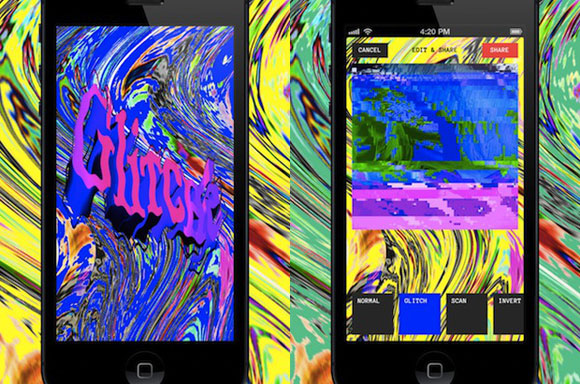
There are plenty of GIF-making apps out there, but none compare to the Internet-ready capabilities of Glitché. Developed by designer Vladimir Shreyder (also spelled Schreider), the app comes with tons of filters and makes it easy to alter, animate and share your own images. The best part is the simple interface, which enables easy frame-by-frame manipulation and sharing across most major social networking sites.
Glitché is as easy to use as it is addictive—I made this GIF in a matter of seconds and then had trouble putting my phone down. A few of the filters even create some extruded, 3D visuals; I took a picture of my laptop keyboard and quickly turned it into this bizarre thing:
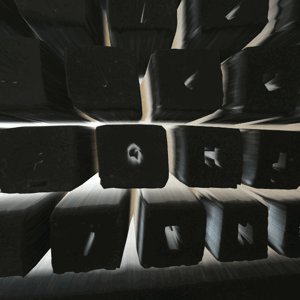
Glitché also feeds into the retro-Nineties aesthetic that dominates certain pockets of the Internet. Glitch art and datamoshing, which carry with it a curiously nostalgic vibe, have spread across visual culture, and increasingly entered the mainstream, whether in Kanye West music videos or David OReilly’s recent Adventure Time episode called “A Glitch is a Glitch.” Apps like Glitché not only make it easier to experiment with looped animation, but also enable a wider audience to participate in major digital art movements.
A few years ago, I offered praise for a Spanish preschool series called Saari, created by Veronica Lassenius and directed by Pablo Jordi. Unfortunately, the show wasn’t easily viewable in many regions. Lassenius and Jordi, who are wife-and-husband, have solved that problem by releasing a new Saari app for iPads and iPhones to distribute episodes of their show.
The app, produced through their new Helsinki-based company Pikkukala, is free and offers a new episode every two weeks. For those who want to watch more episodes, episode packs are available for purchase and downloadable for offline viewing. Visit Apple’s App Store to download Saari TV.
Director and animator Lucas Zanotto proves with his creative new app Drawnimal that drawing with a pencil on paper and digital apps are not incompatible technologies. The iPad/iPhone app not only teaches the alphabet and animals to children, but cunningly encourages kids to draw around their devices to create a complete image of an animal that will then perform an animated action. For more info, go to Drawnimal.com or download it from the Apple store.
Color wheel.
(iphone skin)
©2013 DAiN8)
.jpeg?picon=3281)
By: Dain Fagerholm,
on 3/17/2013
Blog:
Art & Drawings by Dain Fagerholm
(
Login to Add to MyJacketFlap)
JacketFlap tags:
iphone,
3d,
game,
asylum,
kickstarter,
game design,
ios,
dain fagerholm,
handdrawn,
android handheld,
Add a tag
blue girl in cell with hole at top. (asylum game)ink pen and color dye marker on spiral notebook paper
GIF
©2013 DAiN8)
 |
| ©2012 DAiN8) |
Creature holding gem in field.
iPhone and iPod skin
©2013 DAiN8)
Keep dreaming in style with Dain Fagerholm's Gem Creatures! NOW Available for your IPhone!
Creature Skins are thin, easy-to-remove, vinyl decals for customizing your device. Skins are made from a patented material that eliminates air bubbles and wrinkles for easy application.
http://society6.com/dain/©2013 Dain Fagerholm

Wish you could read your favorite literary journal on your digital devices? LitRagger has recently launched, giving indie journals a chance to publish on Apple devices.
Inside of the app, you can subscribe to Bellevue Literary Review, FIELD, Gulf Coast, Hobart, Prairie Schooner, Salamander, Sycamore Review and Willow Springs. If you are interested in adding your literary journal to the mix, you can contact adam [at] litragger [dot] com for more details.
Here’s more from the company: “Apple’s iPad, iPhone, and iPod Touch that is designed specifically for literary journals. Built with the needs of small publishers and university-run magazines in mind, LitRagger simplifies the process of digital publication. No more fancy file types. No more formatting nightmares. LitRagger integrates with the print publishing process you already use, making it easier than ever to put your content on the world’s most popular tablet.”
New Career Opportunities Daily: The best jobs in media.

By: Jerry Beck,
on 9/28/2012
Blog:
Cartoon Brew
(
Login to Add to MyJacketFlap)
JacketFlap tags:
Animade,
Estudio Ronda,
Evan Spiridellis,
Nate Theis,
Storybots,
Shorts,
Business,
Iphone,
Internet/Blogs,
jibjab,
Gregg Spiridellis,
Alla Kinda,
iPad,
Rubber House,
Chris Garbutt,
Max Winston,
Add a tag
Brothers Evan and Gregg Spiridellis, founders of JibJab, were visiting New York yesterday to officially launch their new multi-platform children’s project StoryBots. I met them in the afternoon at Rue 57 near Central Park to learn more about their plans for this new venture.
 JibJab has evolved constantly since it was founded in a Brooklyn garage in 1999. In the beginning, JibJab was known for its goofy online Flash videos like Founding Fathers. The company gained widespread notoriety in 2004 with its election-themed short This Land, and soon became known for its “Year in Review” animated shorts. In 2007, the company pursued a new business model: e-greeting cards with the innovative “Starring You” technology that allowed people to insert themselves into animated cards. Today, the company specializes primarily in e-greeting cards and has over 40 employees in Venice Beach, California.
JibJab has evolved constantly since it was founded in a Brooklyn garage in 1999. In the beginning, JibJab was known for its goofy online Flash videos like Founding Fathers. The company gained widespread notoriety in 2004 with its election-themed short This Land, and soon became known for its “Year in Review” animated shorts. In 2007, the company pursued a new business model: e-greeting cards with the innovative “Starring You” technology that allowed people to insert themselves into animated cards. Today, the company specializes primarily in e-greeting cards and has over 40 employees in Venice Beach, California.
Now, with StoryBots, JibJab is expanding in a bold new direction: children’s entertainment. It’s also their biggest push ever into creating original content. Their vision for StoryBots is to build a “Sesame Street for a connected generation.” Using a cast of colorful, simply designed characters that they call StoryBots, JibJab envisions building “hundreds of products in the coming years” that are designed from the ground-up for mobile and tablet devices. These will include apps, ebooks, games, and videos. Educational content and personaliziation will be a key component of many of these products.
StoryBots could pose a major challenge to old children’s media institutions like Disney and Nickelodeon. Instead of doing what other content producers have done in the past, which is to sell a show to a network, JibJab is redefining what children’s entertainment can be in the 21st century and attempting to fundamentally reshape the long-established distribution models of children’s entertainment. Their savviness with monetizing Web content over the past decade leads one to believe that they may actually be able to pull off their ambitious goals.
The initial StoryBots launch includes five separate products:
StoryBots Starring You StoryBooks: A free iPad app that enables parents to create personalized, animated eBooks that include their child’s name and face in the stories.
StoryBots Starring You Band: A free video series on the web that allows parents to insert their kids directly into music videos and jam out alongside the StoryBots.
The StoryBots ABC Jamboree: A collection of 26 one-minute, foot-tapping music videos designed to help kids recognize the sounds and shapes of the letters of the alphabet.
The StoryBots Activity Center: A place on StoryBots.com where parents can download and print over 100 free coloring, tracing, mazes and word finds to – ironically enough – help get their kids off of the computer and back to the kitchen table with crayons and pencils.
The StoryBots Beep & Boop iPhone app: Turns learning good behavior into a game kids love, bringing old-school reward chart systems into the 21st century. Parents give kids BEEPs for good behavior and BOOPs as reprimands. Parents can use the app to create goals and prizes to motivate and celebrate their children’s achievements.
Much of what the Spiridellis brothers have planned for StoryBots can’t be announced publicly yet, but I can say that their plans are impressive. The ABC Jamboree is an excellent example of what makes StoryBots such a unique endeavor.
JibJab is hiring talented animators from around the world to create content for StoryBots, and giving them freedom to animate the StoryBots characters in their own styles. The end result is animation that is not only educational, but also fun to watch for all ages. Just a few of the artists and studios involved with StoryBots so far include Alla Kinda (Spain), Rubber House (Australia), Animade (UK), Chris Garbutt, and Estudio Ronda (Argentina).
Here are two of the ABC vids by Max Winston (letter L) and Nate Theis (letter N):
There’s also a StoryBots Tumblr with behind-the-scenes artwork from the various StoryBots projects being developed.
I have a brand new piece I want to introduce you to... Here's
Dashing Lads! This piece features two very handsome and very stylish kit-cats who apparently take their time-management skills —and accessories— very seriously.
:D

I wonder if kit cat on the left is thinking that it is TIME... to go shopping for another dapper hat!
And kit-cat on the right looks like he's hiding something... maybe his wallet? (Good intentions!)

The art is available on 100% rag
art prints (framed, if you want), museum-wrapped
canvas (nice, thick 1 1/2" cradle - no frame needed), American Apparel
t's in a variety of colors, note cards, laptop, iphone and ipad skins for both Mac and PC's, and hard iphone cases, made by Case Mate. (I have one. They're great quality.) See everything
here.
I designed certain items with revised lettering or removed the lettering altogether, so each item is designed specifically for the product's dimensions and in the best way to showcase the art!
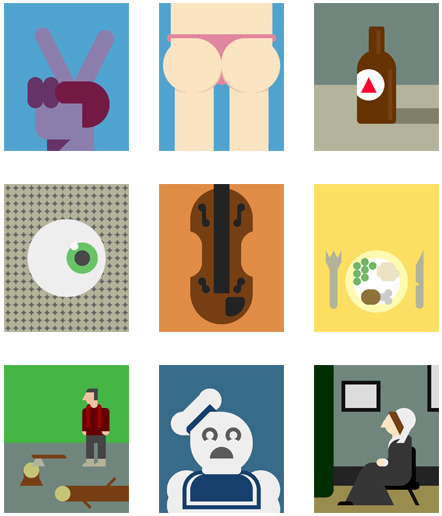
Tim Bierbaum has created dozens of great-looking mini-illustrations using a geometric drawing app for the iPhone called Maru Sankaku Shikaku. Sadly, it’s not available in the Canadian app store, so I can’t try it out for myself, but I love the results.

Ptch is a new iPad/iPhone app that allows users to remix photos, videos, songs and text into 60-second music video-style shorts called Ptches. Sort of like an Instagram for videos (with “styles” instead of filters), Ptch aims to make video editing as intuitive and reflexive for the masses as taking a photograph with a smartphone. The app also allows users to remix ptches made by their friends so that each person can share their own version of an event. The software is available on Apple’s iTunes Store for free, though add-on songs and film “styles” will cost money in the future.
Here’s where it gets interesting. Ptch is headed by Ed Leonard, the Chief Technology Officer of DreamWorks Animation and the former director of R&D at Disney Animation. He convinced DreamWorks CEO Jeffrey Katzenberg to launch a new company called DWA Investments. The company, which is funded entirely by its parent DreamWorks Animation, has 15 employees, a third of whom are former DreamWorks staffers who took paycuts (in exchange for stock) to join Ptch.
Sites like Fast Company and BetaBeat have been debating what Ptch means for the future of DreamWorks. For example, does it signal the company’s transition from being a content producer into a technology company? Ptch helmer Ed Leonard hinted at that possibility while speaking with BetaBeat:
“There’s a lot of ambition at DreamWorks, they’re thinking about how to leverage ambition on the film side and how to reinvent themselves as more of a technology company than a movie company and really leverage all that value. If you get close to what Jeffrey is thinking about in terms of the DreamWorks brand … Jeffrey really believes in the intersection that’s happening between technology and entertainment.”
It’s hard to know what to make of all this just yet, but Leonard’s quote reveals that DreamWorks Animation is evolving in different and unexpected directions.
Cartoon Brew |
Permalink |
No comment |
Post tags: DreamWorks Animation, Ed Leonard, iPad, Jeffrey Katzenberg, Ptch
 |
| oddly, this accidental screenshot was taken when my screen was actually busted and looked totally nothing like this. iphone magic, i guess. |
My iphone died today. I dropped it on a tile floor. I drop it all the time, but today I guess I dropped it in some extra-special way. All the stars aligned, and the screen totally went. I watched in horror as it happened—I actually felt like I was in a movie. I think that all speaks volumes to my iphone attachment, for better or for worse, and how, maybe (and I'm looking for the silver lining here, but
just maybe) it's not a bad thing for me to view this whole debacle as an opportunity for a little self-examination.
For one thing, I do not NEED to use my phone as much as I do. Yes, it is an indispensable tool. Yes, it is the biggest technological revolution since the computer and the internet. Yes, I do
need it—there is no getting around that— it's the swiss army knife of productivity for me.... BUT (you knew this was coming!) the iphone does not have a conscience. It does not have an opinion. It can't tell me what it thinks I should or shouldn't spend my time doing. (Kazoo, anyone? Flinstones?) It can only go where I tell it to go, do what I tell it to do. That, unfortunately, can sometimes add up to a fair amount of time goofing off. Time that would be much better spent with my sketchbook, or my notebook... or even just hanging out with my dog more. I'm certain of this. Sure, I mostly use it for productivity-laced activities.
I read helpful e-books on it. I have so many tools on it that help me communicate with others, deliver files to people, and generally keep things running well. The phone itself even assists me with off-line creative work in several ways.
And when I do play a game, it's often Draw Something, which I consider a casual but engaging creative exercise, not a waste of time.
But... my iphone can't tell me to knock it off when I take the off-ramp into junkdom (Hello, Us Weekly!). It can't coach me to curb my Instagramming. (Hey I love Instagram, but I also love pie, and if I ate pie the way I Instagram..) It doesn't set a timer when I'm making photo collages in PicFrame, my latest obsession. (Think they should make an app for that?)So, I'm coming clean: On some level, my iphone addiction actually
bothers me! Yes, It
is an uber-productivity tool, but it's also an uber-
time-suck-and-goof-off tool if one is not really careful about it. This is something I've been aware of. It's not a secret. But here I am,
now, in
this situation. And it's really a great, gifty opportunity to investigate my phone habits and take steps to revise them where needed. I'm not saying it's great that I dropped and accidentally killed my phone. But I
am glad that I'm self-aware enough to see this as a chance to make some small changes that I think will add up, and eventually improve— ironically—
my productivity. Definitely, when it comes to sketchi

Animation professionals are pushing the limits of the field every day on the big and the small screen, but veteran animator and storyboard artist Ryan Woodward is breaking new ground right in your hands: on phones and tablet devices. Debuting last Friday, Woodward’s Bottom of the Ninth is an iOS app that is both a graphic novel and animated short film, with each comic panel acting as a frame for a short piece of the animated work. Using the skills accumulated from his seventeen years in animation, he’s broken out on his own with a small team of animators, programmers, musicians and voice-over talent to push the boundaries of what people think of as animation. Woodward has created what he calls “the first animated graphic novel,” and not just simple sliding graphics as in many animated comics, but a graphic novel featuring full character animation.
The story of Bottom of the Ninth is set 200 years in the future and revolves around a young girl named Candy gifted with phenomenal talent on the baseball field. Her father, a retired pro baller named Gordy, is training her to harness her raw talent into the skills needed to become a pro in their futuristic version of baseball, dubbed “New Baseball,” that comes complete with artificial gravity and vertical infields. With Candy’s talent she might be a shoe-in, but as anyone who’s parented a teenager or been one themself (don’t deny it), work is the last thing on her mind.
Ryan Woodward jumped into the animation field in 1995 fresh out of Brigham Young University, cutting his teeth in the trenches on Space Jam and the film’s polar opposite, The Iron Giant . As a young artist, Woodward apprenticed under a number of notable animators including Michel Gagné. In recent years, Woodward has transferred his talent to the CG realm and worked on this year’s The Avengers and Snow White and the Huntsman. After hours, he has continued to work on personal projects like the award-winning short film Thought of You ,and now, Bottom of the Ninth.
The first chapter of Bottom of the Ninth is available now for $3.99 from the iTunes App Store, with plans to release future chapters as In-App purchases.
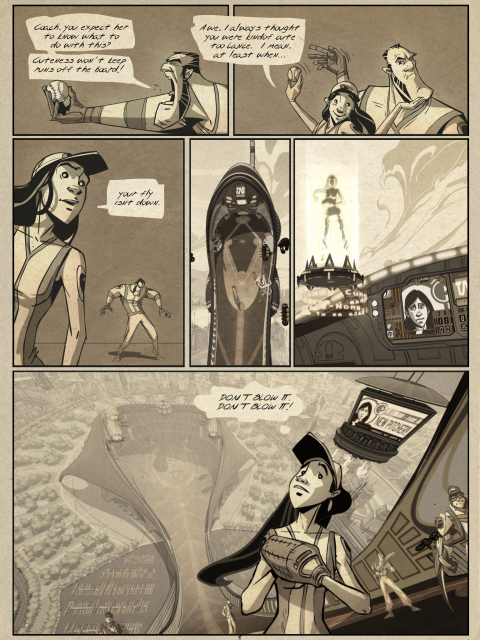
Chris Arrant: Ryan, you’ve had an extensive career working in theatrical animation and live-action films, but I was surprised to learn that you’d trained under animator Michel Gagné at Warner Bros., an industry veteran who has similarly pursued his own creative path. How do you balance a busy career working on major feature films while creating ambitious independent projects like Bottom of the Ninth?
Ryan Woodward: Not easy. But guys like Michel and also Acturas Actas taught me to have passion for this art form and they taught me the value of pursuing my own dreams along with supporting great feature productions. In the end it comes down to wanting to feel human. I want to feel like I’m arriving to my potential. The studio system is great and I learned a ton there, but the need for specialists in that industry limit you to how much you want to grow in other areas, and I’ve always wanted to grow and be a much more well-rounded production artist. And when you do your own production, you have to animate, wri
View Next 25 Posts












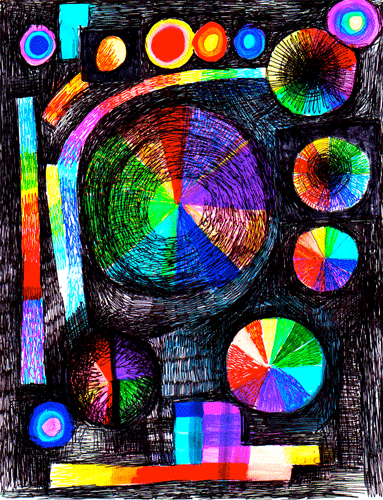






 JibJab has evolved constantly since it was founded in a Brooklyn garage in 1999. In the beginning, JibJab was known for its goofy online Flash videos like
JibJab has evolved constantly since it was founded in a Brooklyn garage in 1999. In the beginning, JibJab was known for its goofy online Flash videos like 





I’ve had my Kindle Fire HD for 3 years now, still in great working condition. I’ve no desire to buy a new tablet since my current one is still rocking. I read tons of comics on it, from comixology and now my local library whom rents their digital editions in cooperation with amazon.com.
“Since Amazon’s acquisition of ComiXology in April 2014, it has become essentially the de facto standard for digital comics and now distributes just about every publisher around.”
Except of course for those it refuses to distribute. Amazon is now in the same position as Diamond: they can’t stop you from selling your comic, but they can stop you from using the largest market for comics readers.
As for the questions posed here… Larger screens are nicer for reading, but I don’t see a lot of people investing in $800 tablets just to get a large-print version of their comics. Especially since creators/publishers have to produce and format their work with 7-inch tablets in mind.
I like reading comics on my 9.7 iPad. I think the iPad mini or even my daughters 7″ Kindle Fire are too small for comics reading however. I’d love an iPad pro to read my comics on but I don’t want to carry that huge screen around with me when I travel. If money was no object, I’d buy the pro for home and keep my 9.7 for traveling but as it stands, the 9.7 is the best all around screen size for me personally and that’s what i’ll buy when it’s time to upgrade my current tablet.
Hoopla, the digital content platform used by many public libraries has done an impressive job bringing comics to their digital offerings. My local library added hoopla comics last month, and I was surprised by the relatively new content across major publishers with some such as Boom offering single issues. The hoopla titles are able to read in both fit-to-screen and panel view mode. Has anyone else used Hoopla? My library limits to 10 digital hoopla items a month and I’m wondering if this is the same everywhere.
I read a lot of comics on my Galaxy Tab 3 which is “old” (is 2 year & a half old ?) and it does the job really well. When it doesn’t Comixology Guided View do the trick. :)
I don’t think about changing my tablet soon and I don’t see why I should or how it should affect the comics market. After all, I’m concerned about digital comics not hardware. So as long as Comixology (or Image Comics for instance) is doing money, my collection is still safe. :)
I switched from an iPad to a Samsung Galaxy Note 10.1 about 6-8 months ago. I use it for all my comic reading. I stuck with iPad for a long time because I was so invested in the infrastructure (apps and games), but I’m sick of the high prices and the lack of expandable memory. The first thing I did with my Samsung was stick a 64 GB micro SD card in it.
To sort of “protect” my Apple investment, I did move to a larger iPhone 6 Plus so I can use my phone for more “tablet” things, but I’ve yet to read any comics on it. I have read a magazine and of course books, but comics are so much more visual I like the large screen for reading. I do like the idea of a 12.9 inch screen, but I won’t buy one until an Android manufacturer produces one (and my current tablet gets older/outdated).